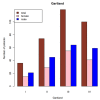Supracondylar Fractures of the Humerus: Association of Neurovascular Lesions with Degree of Fracture Displacement in Children-A Retrospective Study
- PMID: 35327679
- PMCID: PMC8946881
- DOI: 10.3390/children9030308
Supracondylar Fractures of the Humerus: Association of Neurovascular Lesions with Degree of Fracture Displacement in Children-A Retrospective Study
Abstract
Supracondylar humerus fractures (ScHF) account for 60% of fractures of the elbow region in children. We assessed the relationship between neurovascular complications and the degree of fracture displacement as rated on the basis of modified Gartland classification. Moreover, we aimed to evaluate predisposing factors, e.g., age and gender, and outcomes of neurovascular complications in ScHF. Between 2004 and 2019, we treated 329 patients with ScHF at the Department of Traumatology and Orthopedics of the Upper Silesian Child Centre, Katowice, Poland. Mean age of patients (189 boys and 140 girls) was 7.2 years (Confidence interval: 6.89, 7.45). Undisplaced fractures were treated conservatively with a cast. Displaced fractures were managed by closed reduction and percutaneous Kirschner wire fixation using two pins inserted laterally. We retrospectively assessed the number of neurovascular lesions at baseline and recorded any iatrogenic injury resulting from the surgical intervention. Acute neurovascular lesions occurred in 44 of 329 ScHF patients (13.4%). The incidence of accompanying neurovascular injuries was positively associated with the severity of fracture displacement characterized by Gartland score. Vascular injuries occurred mainly in Gartland type IV ScHF, while nerve lesions occurred in both Gartland type III and IV ScHF. We noted a significantly higher mean Gartland score and mean age at injury in the group of children suffering from neurovascular injuries when compared to those in the group without such injuries (p = 0.045 and p = 0.04, respectively). We observed no secondary nerve lesions after surgical treatment. For the treatment of ScHF in children, we recommend closed reduction and stabilization of displaced fractures with K-wires inserted percutaneously from the lateral aspect of the upper arm. We advocate vessel exploration in case of absent distal pulses after closed reduction but do not consider primary nerve exploration necessary, unless a complete primary sensomotoric nerve lesion is present.
Keywords: children; neurologic injury; supracondylar humerus fractures; treatment; vascular injury.
Conflict of interest statement
The authors declare no conflict of interest.
Figures
Similar articles
-
[Failure of the primary treatment of displaced supracondylar humerus fractures in children].Acta Chir Orthop Traumatol Cech. 2014;81(1):57-62. Acta Chir Orthop Traumatol Cech. 2014. PMID: 24755058 Czech.
-
Operative treatment of supracondylar fractures of the humerus in children. The consequences of pin placement.J Bone Joint Surg Am. 2001 May;83(5):735-40. J Bone Joint Surg Am. 2001. PMID: 11379744
-
Identifying Risk Factors for Open Reduction in Pediatric Supracondylar Humerus Fractures.J Pediatr Orthop. 2024 Nov-Dec 01;44(10):573-578. doi: 10.1097/BPO.0000000000002784. Epub 2024 Aug 5. J Pediatr Orthop. 2024. PMID: 39099078
-
Comparison of lateral entry with crossed entry pinning for pediatric supracondylar humeral fractures: a meta-analysis.J Orthop Surg Res. 2018 Apr 3;13(1):68. doi: 10.1186/s13018-018-0768-3. J Orthop Surg Res. 2018. PMID: 29615086 Free PMC article.
-
The Pulseless Supracondylar Elbow Fracture: A Rational Approach.Indian J Orthop. 2020 Oct 13;55(1):47-54. doi: 10.1007/s43465-020-00273-6. eCollection 2021 Feb. Indian J Orthop. 2020. PMID: 33569098 Free PMC article. Review.
Cited by
-
Retrospective Mid-Term Follow-Up of Posttraumatic and Iatrogenic Neurovascular Complications in Surgically Treated Paediatric Patients with Distal Humerus Fracture.Children (Basel). 2022 Sep 4;9(9):1349. doi: 10.3390/children9091349. Children (Basel). 2022. PMID: 36138658 Free PMC article.
-
Median nerve lesions in pediatric displaced supracondylar humerus fracture: A prospective neurological, electrodiagnostic and ultrasound characterization.Eur J Neurol. 2024 Dec;31(12):e16459. doi: 10.1111/ene.16459. Epub 2024 Sep 4. Eur J Neurol. 2024. PMID: 39230443 Free PMC article.
-
Relationship Between Blurred Boundary and Neurological Deficits in Extension-Type Pediatric Supracondylar Humeral Fractures.JB JS Open Access. 2025 Aug 15;10(3):e25.00153. doi: 10.2106/JBJS.OA.25.00153. eCollection 2025 Jul-Sep. JB JS Open Access. 2025. PMID: 40823475 Free PMC article.
-
Fishtail Deformity after Type 2 Supracondylar Humerus Fracture with Development of Symptomatic Loose Body: A Case Report.J Orthop Case Rep. 2023 Jul;13(7):90-94. doi: 10.13107/jocr.2023.v13.i07.3766. J Orthop Case Rep. 2023. PMID: 37521382 Free PMC article.
-
The first analysis of a multicentre paediatric supracondylar humerus fracture (SCHF) registry by fracture type.Arch Orthop Trauma Surg. 2024 Dec 12;145(1):39. doi: 10.1007/s00402-024-05644-4. Arch Orthop Trauma Surg. 2024. PMID: 39666055 Free PMC article.
References
-
- Cheng J.C., Lam T.P., Maffulli N. Epidemiological features of supracondylar fractures of the humerus in Chinese children. J. Pediatr. Orthop. 2001;10:63–67. - PubMed
LinkOut - more resources
Full Text Sources
Miscellaneous




